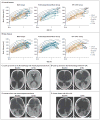Endoscopic Treatment versus Shunting for Infant Hydrocephalus in Uganda
- PMID: 29262276
- PMCID: PMC5784827
- DOI: 10.1056/NEJMoa1707568
Endoscopic Treatment versus Shunting for Infant Hydrocephalus in Uganda
Abstract
Background: Postinfectious hydrocephalus in infants is a major health problem in sub-Saharan Africa. The conventional treatment is ventriculoperitoneal shunting, but surgeons are usually not immediately available to revise shunts when they fail. Endoscopic third ventriculostomy with choroid plexus cauterization (ETV-CPC) is an alternative treatment that is less subject to late failure but is also less likely than shunting to result in a reduction in ventricular size that might facilitate better brain growth and cognitive outcomes.
Methods: We conducted a randomized trial to evaluate cognitive outcomes after ETV-CPC versus ventriculoperitoneal shunting in Ugandan infants with postinfectious hydrocephalus. The primary outcome was the Bayley Scales of Infant Development, Third Edition (BSID-3), cognitive scaled score 12 months after surgery (scores range from 1 to 19, with higher scores indicating better performance). The secondary outcomes were BSID-3 motor and language scores, treatment failure (defined as treatment-related death or the need for repeat surgery), and brain volume measured on computed tomography.
Results: A total of 100 infants were enrolled; 51 were randomly assigned to undergo ETV-CPC, and 49 were assigned to undergo ventriculoperitoneal shunting. The median BSID-3 cognitive scores at 12 months did not differ significantly between the treatment groups (a score of 4 for ETV-CPC and 2 for ventriculoperitoneal shunting; Hodges-Lehmann estimated difference, 0; 95% confidence interval [CI], -2 to 0; P=0.35). There was no significant difference between the ETV-CPC group and the ventriculoperitoneal-shunt group in BSID-3 motor or language scores, rates of treatment failure (35% and 24%, respectively; hazard ratio, 0.7; 95% CI, 0.3 to 1.5; P=0.24), or brain volume (z score, -2.4 and -2.1, respectively; estimated difference, 0.3; 95% CI, -0.3 to 1.0; P=0.12).
Conclusions: This single-center study involving Ugandan infants with postinfectious hydrocephalus showed no significant difference between endoscopic ETV-CPC and ventriculoperitoneal shunting with regard to cognitive outcomes at 12 months. (Funded by the National Institutes of Health; ClinicalTrials.gov number, NCT01936272 .).
Figures



Similar articles
-
Neurocognitive outcome and ventricular volume in children with myelomeningocele treated for hydrocephalus in Uganda.J Neurosurg Pediatr. 2009 Dec;4(6):564-70. doi: 10.3171/2009.7.PEDS09136. J Neurosurg Pediatr. 2009. PMID: 19951045
-
Comparison of hydrocephalus metrics between infants successfully treated with endoscopic third ventriculostomy with choroid plexus cauterization and those treated with a ventriculoperitoneal shunt: a multicenter matched-cohort analysis.J Neurosurg Pediatr. 2018 Apr;21(4):339-345. doi: 10.3171/2017.10.PEDS17421. Epub 2018 Feb 2. J Neurosurg Pediatr. 2018. PMID: 29393809
-
Treatment of hydrocephalus following fetal repair of myelomeningocele: comparing endoscopic third ventriculostomy with choroid plexus cauterization to ventricular shunting.J Neurosurg Pediatr. 2024 Jun 21;34(3):207-215. doi: 10.3171/2024.5.PEDS24171. Print 2024 Sep 1. J Neurosurg Pediatr. 2024. PMID: 38905709
-
Endoscopic Third Ventriculostomy And Choroid Plexus Coagulation in Infants: Current Concepts and Illustrative Cases.Neurol India. 2021 Nov-Dec;69(12 Suppl 2):S514-S519. doi: 10.4103/0028-3886.332270. Neurol India. 2021. PMID: 35103010 Review.
-
Mortality and complications 1 year after treatment of hydrocephalus with endoscopic third ventriculostomy and ventriculoperitoneal shunt in children at Queen Elizabeth Central Hospital, Malawi.Acta Neurochir (Wien). 2023 Jan;165(1):61-69. doi: 10.1007/s00701-022-05392-7. Epub 2022 Oct 25. Acta Neurochir (Wien). 2023. PMID: 36282428 Review.
Cited by
-
Neuroendoscopy for post-infective hydrocephalus in children.Childs Nerv Syst. 2018 Oct;34(10):1905-1914. doi: 10.1007/s00381-018-3901-z. Epub 2018 Aug 11. Childs Nerv Syst. 2018. PMID: 30099619 Review.
-
Endoscopic third ventriculostomy in children with third ventricular pressure gradient and open ventricular outlets on MRI.Childs Nerv Syst. 2019 Dec;35(12):2319-2326. doi: 10.1007/s00381-019-04383-x. Epub 2019 Oct 25. Childs Nerv Syst. 2019. PMID: 31654263
-
The burden, prevention and care of infants and children with congenital anomalies in sub-Saharan Africa: A scoping review.PLOS Glob Public Health. 2023 Jun 28;3(6):e0001850. doi: 10.1371/journal.pgph.0001850. eCollection 2023. PLOS Glob Public Health. 2023. PMID: 37379291 Free PMC article.
-
Low surgical weight associated with ETV failure in pediatric hydrocephalus patients.Neurosurg Rev. 2024 Apr 22;47(1):176. doi: 10.1007/s10143-024-02423-y. Neurosurg Rev. 2024. PMID: 38644441
-
Outcomes of the 2019 hydrocephalus association workshop, "Driving common pathways: extending insights from posthemorrhagic hydrocephalus".Fluids Barriers CNS. 2023 Jan 13;20(1):4. doi: 10.1186/s12987-023-00406-7. Fluids Barriers CNS. 2023. PMID: 36639792 Free PMC article. Review.
References
-
- Warf BC. Educate one to save a few, educate a few to save many. World Neurosurg. 2013;79(2 Suppl):S15.e15–S15.e18. - PubMed
-
- Warf BC. Hydrocephalus in Uganda: the predominance of infectious origin and primary management with endoscopic third ventriculostomy. J Neurosurg. 2005;102:1–15. - PubMed
-
- Warf BC, Alkire BC, Bhai S, et al. Costs and benefits of neurosurgical intervention for infant hydrocephalus in sub-Saharan Africa. J Neurosurg Pediatr. 2011;8:509–21. - PubMed
-
- Warf BC. Comparison of 1-year outcomes for the Chhabra and Codman-Hakim Micro Precision shunt systems in Uganda: a prospective study in 195 children. J Neurosurg. 2005;102:358–62. - PubMed
-
- Lane JD, Mugamba J, Ssenyonga P, Warf BC. Effectiveness of the Bactiseal Universal Shunt for reducing shunt infection in a sub-Saharan African context: a retrospective cohort study in 160 Ugandan children. J Neurosurg Pediatr. 2014;13:140–4. - PubMed
Publication types
MeSH terms
Associated data
Grants and funding
LinkOut - more resources
Full Text Sources
Other Literature Sources
Medical
